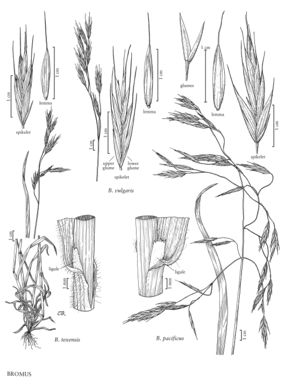Bromus texensis
Plants annual. Culms 30-70 cm, erect or spreading; nodes 3-5, pubescent. Sheaths densely pub¬escent to pilose; auricles absent; ligules 2-3 mm, lanceolate, pub¬escent, obtuse, erose; blades 7-20 cm long, 3-7 mm wide, flat, usually pubescent to pilose, rarely glabrous. Panicles 8-15 cm, open, drooping; branches ascending to spreading. Spikelets 20-30 mm, elliptic to lanceolate, terete to moderately laterally compressed, with 4-7 florets. Glumes glabrous or hispidulous; lower glumes 6-9 mm, 1-veined; upper glumes 8-10.5 mm, 3-veined, usually acute, rarely mucronate; lemmas 9-15 mm, lanceolate, rounded over the midvein, glabrous, sometimes scabrous, apices subulate to acute, entire; awns 4-8 mm, straight, arising less than 1.5 mm below the lemma apices; anthers 3-5 mm. 2n = 28.
Discussion
Bromus texensis grows in openings in brushy areas on rocky ground. It is rare, found only southern Texas and northern Mexico.
Selected References
None.
